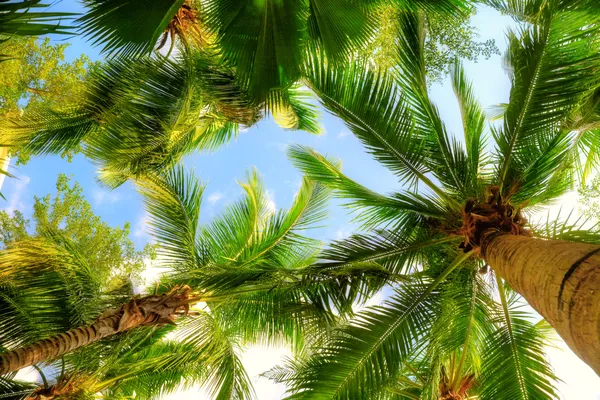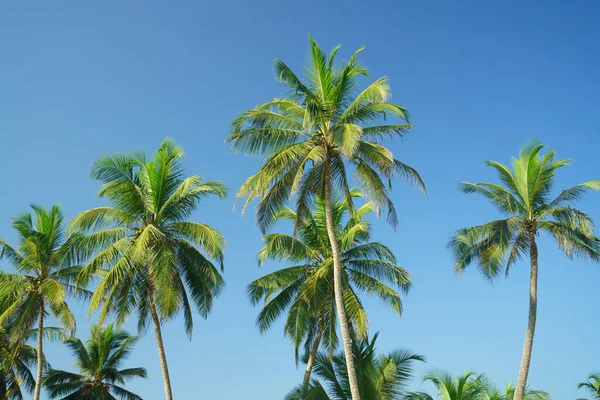
Palm Trees 101: Great Mysteries and Benefits
Palm trees belong to the monocotyledon family’s flowering plants, and the scientific name is Palmae. It consists of a long, slender stem that is green when the palm is young and turns grey as time passes. Its leaves are called fronds, and its base is smooth and green. Its basic structure consists of needle-shaped, curved leaves with a sharp, hard tip. One palm tree contains 30 to 50 fronds.
As for its flowers, they are either creamy white or yellow, and the same palm tree contains male and female flowers. The female flowers are larger, have three petals and three sepals, are concentrated at the base of the fronds, and are recognised from the male flowers by these characteristics.
As for the male flowers, they are small in size and extend towards the ends. It consists of three petals and a cup divided into three lobes. Most palm trees are between 10 and 15 metres tall; however, some can grow up to 30 metres tall.
There are numerous types of palm trees, all of which differ from one another and are widely distributed around the world. Palm trees live for many years, during which they provide people with delicious fruits of high nutritional value, specifically date palm trees.
The cultivation of palm trees requires full knowledge of how to propagate and cultivate them, irrigation requirements, and the conditions that must be available in the environment in which they are grown to live longer periods.
The Ancient Egyptian civilisation was one of the most important civilisations that relied on dates for the production of food and wine. Research says that the Pharaohs and the people of ancient Egypt planted and exploited another type of their date palm, which is the Doum palm, and Egypt and the Nile Basin are considered the home of this ancient type. Archaeologists in Egypt found a number of dates in the tomb of Tutankhamun in 2007. Pharaohs have always considered palm trees a symbol of long life.
The Italian scientist Eduardo Bacardi, a researcher in agricultural sciences, claims that the original homeland of palm trees is the Arabian Gulf. He based his argument on that by saying that there is a genus of palm trees whose growth flourishes only in subtropical regions where rain is scarce. Its roots require an abundance of moisture and resist salinity to a large extent. These qualities are only available in the region west of India and south of Iran or on the western coast of the Persian Gulf.
Let’s now take a tour around palm trees to discover their world, environment, and characteristics.
Table of Contents
How many years does it take a palm tree to bear fruit?
The palm tree needs up to 12 years of age to start producing dates; after the trees reach 36 meters in length, and continue to produce dates until their death, and despite the trees’ ability to withstand heat and drought, they need water in abundant quantities during the flowering season. Fruiting, just as flowers need care against pests to remain healthy, they also need fertiliser that provides them with nutrients.
How many years does a palm tree live?
Palm trees are classified as perennial trees, as they may live for a period ranging between 70-100 years, and this period may increase if the owner of the farm takes care of the palm trees and feeds them with appropriate fertilisers and some types of palms, such as coconut palms, live on average for a period ranging between 80-90 years, but the type The best is the date palm, which produces dates for 100 years, that is, throughout its life. There is a species that lives only 40 years, and it is the relatively short areca palm that is found in homes.
Palm Reproduction
Palm trees usually reproduce in two main ways:
Vegetative propagation
Vegetative propagation or asexual propagation is defined as the germination of palm trees using branches instead of seeds through offshoots and green branches that grow next to the base of palm trees in the form of buds. These offshoots can be exploited to propagate palm trees as follows:
- Sterilize a sharp knife or sharp tree scissors by immersing it in rubbing alcohol. These tools should be avoided with chlorine or any bleach because they cause damage to the tree.
- Wear gloves and protective eyewear to avoid injury to rough palm leaves.
- The appropriate time to cut the tree’s offshoots is spring, as in this season, the offshoots have passed a year and have grown roots.
- Cut the outer leaves of the branches, leaving some, then tie the high branches together and start digging the soil around these branches to reach the base.
- Carefully cut the branch and separate it from the mother tree without damaging them.
- Fill a large pot with soil for palm trees, moisten it with water, and plant the branch in it.
- Place the pot in a bright area with temperatures that are between 19 and 20 degrees Celsius at night and 30 degrees Celsius during the day. When it is below 18 degrees Celsius in the winter, it is advisable to move the pot to a warm location indoors.
- The container needs to be well-draining, and after watering the branch, wait for its soil to dry before watering it once more.
- After two years, the branch can be moved to be planted in the ground soil.
Reproduction
Palm trees can be germinated using seeds by following these steps:
- Buy palm seeds from specialized places for selling seeds or from flowering palm trees, and it is preferable that they be modern so that they grow faster.
- Put the seeds in a container full of water to test the viable ones. Those seeds that float are not good because they lack the internal parts necessary for reproduction, while the seeds that settle at the bottom of the container are considered good, and there is a large percentage of the success of their cultivation.
- Put good seeds in a small pot containing a small amount of soil, then cover them with a thin layer of soil to facilitate their growth, as the seeds are not viable if planted in deep soil.
- Keep the soil pot in a warm and moist place. It can be placed on the bathroom window near the steam. It can also be placed on top of the refrigerator or on a sunny windowsill to keep warm.
- Wait for about 70 days for the young plant to emerge from the seed. This period may sometimes extend to about six months, depending on the quality of the seeds and their environment.
- Transferring the plant to a warm place, the temperature of which is not less than 18 or 19 degrees Celsius, and it receives ample sunlight for long periods of time daily.
- Transferring the plant to outdoor soil at the beginning of spring, after it has grown at least four leaves to resist external conditions and keep the soil always moist.
- Start fertilizing palm trees in small quantities, using a liquid fertilizer intended for palm trees after the plant grows at a good rate.
- After the date palm grows, its female flowers will need to be pollinated by the male flowers, which insects and wind play a major role in that, as pollen grains are transferred from the female flowers to the male ones to complete the stage of sexual reproduction and fruit growth, and this process is repeated throughout the life cycle of the palm continuously.
Palm Growth Stages
The palm tree goes through several stages from the beginning of its growth, through the production of fruits, and ending with its death, and the following few lines show the palm life cycle:
- Germination stage: It is the stage of root growth from the seed, the plant splitting the soil from the seed above the surface of the soil, and the growth of the first leaf on it.
- Vertical growth stage: the plant follows the sun’s rays and grows vertically upwards; new leaves appear from the top, and old leaves fall off the bottom of the trunk.
- Cylindrical growth stage: in which the palm tree’s trunk grows widthwise and continuously expands from the bottom. The tree erects from the top, producing a cylindrical stem, which its division distinguishes into several parts in the same horizontal plane.
- Flowering stage: After the palm tree grows up, it begins to bloom in the warm seasons, and the palm flowers appear small and clustered on each other. These trees may bloom annually or once during their entire life cycle.
- Fruiting stage: The female palm flowers need to be pollinated with pollen from the male trees in order for these flowers to contract and turn into fruits, and bees or bats usually play an essential role in the pollen transfer process, and the fruits (dates) grow on palm trees in clumps or large groups They are ready to be harvested after they are fully ripe, and this process is repeated throughout the life cycle of the palm tree, which extends for years.
- Annihilation stage: in which the stem of the palm tree begins to wither or dry from the bottom, and the fronds and cylindrical scales in its stem stop growing, and this indicates the beginning of the death of the palm tree, and it may also die of natural causes such as disasters and strong winds.
Types of Palm Trees
There are numerous varieties of palm trees; the most significant are explained below:
- Date palm: It is the most well-known variety of palm. Fruits that are delectable, healthy, and common are produced in the Middle East. These trees reach a height of around 30 metres, and their leaves can grow to a length of between three and five metres. They can survive difficult environmental circumstances like drought, a lack of water, and high temperatures.
- Zombie palm: These trees are famous in Hispaniola, specifically in the dry hilly areas, as they grow to relatively few heights of up to 3 meters, and smaller branches always grow next to them, and they produce white, circular fruits, and they are characterised as being able to withstand drought.
- Windmill palm: The Chinese windmill palm’s scientific name is Trachycarpus. The original habitats of this type are Japan, China, Myanmar, and India. It is an evergreen species of about 30 meters in height and a width ranging from 2 to 4 meters. What distinguishes this type of palm tree most is that it tolerates extreme cold and contains disease-resistant genes. And agricultural pests, and you don’t need much effort to care for them.
- King palm: It was named by this name for its elegant appearance, its eye-catching bright green leaves, its attractive spring flowers, its slender multi-coloured trunk, and its leaves wrapped around each other. This type of palm grows in California and is distinguished for not requiring intensive care for its growth.
- Triangle palm: These trees grow in the Mediterranean rainforests because they need a warm and humid environment to grow and reach a height of about 15 meters. They can be grown in California and Hawaii.
How to grow palm trees?
Here are the steps for palm cultivation:
- Place the young palm plant in soil rich in minerals and nutrients.
- The palm plant can be fertilised with the correct nutrients that palm trees require after it has been in the ground for three to four months.
- For five to six months, water the little palm plant twice per week; if the soil is sandy, the irrigation schedule can be raised to three times per week.
- The plant has to be watered once a month in the winter and twice a month in the summer seasons after six months of growth.
- Pruning palm trees and getting rid of brown and yellow branches because these leaves consume nutrients from the soil and prevent them from reaching the tree to complete its growth.
- Avoid cutting the branches near the original trunk of the palm tree. It is preferable to leave a small part of these branches in order to avoid wounding the trunk of the palm tree.
What are the uses of the palm tree?
A palm tree has many uses, as the wood resulting from its trunk is used in carpentry and construction. In addition to the following:
- It is also used for the purpose of heating in the winter as firewood, as well as fertilizer for plants and trees.
- Its wood is used in the manufacture of cardboard and paper.
- The flowers of this tree are used to make pollen water, which has many uses and is commonly used in the Arab Gulf countries.
- It is used for decorative purposes in streets and gardens and for shading land areas from sunlight.
- It is considered one of the ornamental trees that crowd the streets of some cities.
- Its leaves are used to build the roofs of some houses.
- It is used in the manufacture of chairs and papers.
- Its trunks are used in the preparation of some building materials.
- Its roots are involved in fuel generation and fertiliser manufacturing.
- Palm leaves are used in the manufacture of some women’s supplies, such as bags and cosmetics.
Benefits of palm tree fruit
The benefits of the palm tree are not limited to the previous aspects but rather extend to the following:
- It is considered an integrated food that contains a high percentage of most nutrients, minerals, and vitamins that the body needs on a daily basis to be able to perform its vital operations and to maintain the health of its internal and external organs.
- It contains protein and calcium that help grow and strengthen the body.
- It contains iron, which prevents anaemia.
- Its fruits are used to help relieve the digestive system, especially the problem of constipation, and are also useful for haemorrhoids and cases of colon irritation.
- It greatly reduces the possibility of food poisoning.
- It is useful to help treat skin problems, especially allergies and is also used to help treat high-pressure problems.
- Interferes in the manufacture of both sucrose and molasses.
- It is beneficial for pregnant women, especially in the last weeks of pregnancy, because it facilitates the process of childbirth, reduces the pain associated with it, and reduces miscarriage possibilities.
- It is useful for those who suffer from obesity and are overweight.
- It maintains cholesterol within its normal levels, as it contains pectin, which is responsible for regulating cholesterol levels.
- It protects from colon cancer.
- It prevents haemorrhoids, as it helps to get rid of chronic constipation that causes it, as it contains fast-digesting sugars and fibre.
- It protects the teeth and prevents them from decay, as it contains fluorine, which is responsible for the health and safety of the gums.
- The body gets rid of its toxins and prevents their accumulation in it, as it contains sodium and potassium that help diuresis.
- It prevents and treats anaemia, as it contains iron and copper, which are responsible for building and forming haemoglobin in the blood.
- It increases sexual ability and desire, as it is rich in boron and vitamin A.
- It is scientifically proven useful in strengthening the liver.
- It reduces skin infections and bleeding and increases its smoothness and freshness.
- It eliminates worms.
- It relieves colitis and treats irritation.
- It relieves and treats stomach acidity, as it contains chlorine, potassium and sodium.
- It relieves headaches, pain, nausea, and dizziness.
- It treats food poisoning problems.
- It facilitates childbirth and relieves pain.
Palm trees are widely spread worldwide, and there are many different types, each with characteristics that distinguish them from others. Palm trees live for many years, providing people with delicious fruits of high nutritional value, precisely date palm trees. Cultivating palm trees requires complete knowledge of how to propagate and cultivate them, irrigation requirements, and the conditions that must be available in the environment where they are grown to live more extended periods.
If you found this article interesting, you may also like reading about Stones, Healing Stones, Wood Facts, and Facts about Rocks.
Why not subscribe to our LearningMole Library for as little as £1.99 per month to access over 1500 fun educational videos.





Leave a Reply